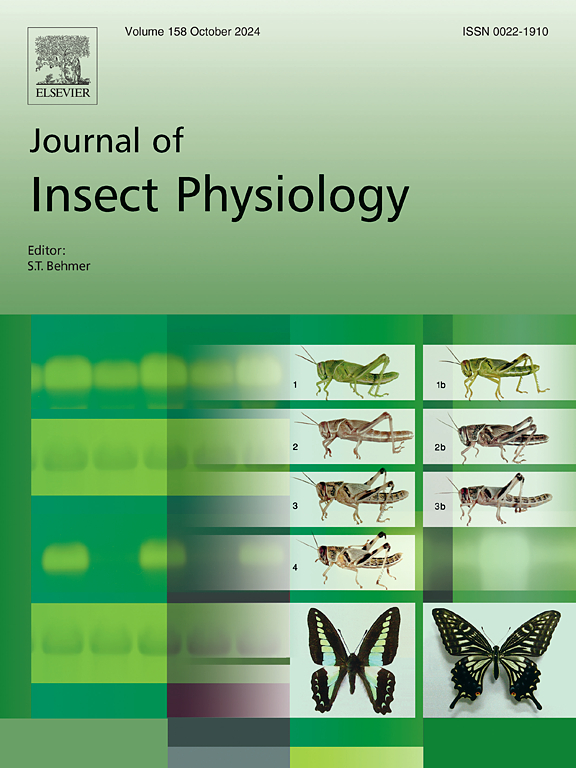营养质量对豌豆蚜出生后翅膀形态的影响
IF 2.3
2区 农林科学
Q1 ENTOMOLOGY
引用次数: 0
摘要
蚜虫可以根据环境变化产生有翅或无翅的后代。寄主营养是影响蚜虫翅膀形态可塑性的广泛研究的环境因素之一。在这项研究中,我们发现豌豆蚜(Acyrthosiphon pisum)在以植物为食的情况下,产生有翅后代的比例较低,但在以人工食物为食的情况下,产生有翅后代的比例明显较高。有趣的是,当新生若虫在植物上取食六小时或更长时间后,再将其转回人工饲料时,大多数若虫都变得没有翅膀。这些结果表明,豌豆蚜的翅膀形态状态在出生后会发生变化,这可能是由食物的营养质量决定的。此外,与吃植物的蚜虫相比,吃人工食物的蚜虫表现出更高的葡萄糖水平和更强的胰岛素信号活动。相反,以人工饲料喂养的蚜虫体内氨基酸水平较低,TOR信号转导较弱。胰岛素和雷帕霉素靶标(TOR)是参与控制生物体生长的主要营养传感信号通路,并与蚜虫翅膀形态可塑性的调节有关。我们测试了这些营养响应途径是否参与了蚜虫肛后翅的决定。然而,降低日粮中的氨基酸含量或使用雷帕霉素抑制 TOR 会导致有翅形态的减少,这表明较低的氨基酸水平或 TOR 活性并不是人工日粮中有翅形态比例较高的原因。这些结果表明,营养质量,尤其是蔗糖和葡萄糖等糖类,可能通过胰岛素信号途径调节豌豆蚜出生后的翅膀形态。本文章由计算机程序翻译,如有差异,请以英文原文为准。

Nutritional quality regulates postnatal wing morph in pea aphids
Aphids can produce winged or wingless offspring in response to environmental changes. Host nutrition is one of the extensively studied environmental factors influencing the plasticity of wing morphs of aphids. In this study, we found that the pea aphid, Acyrthosiphon pisum, produced a low proportion of winged offspring when fed on plants, but a significantly higher proportion on the artificial diet. Interestingly, when newly born nymphs were transferred back to the artificial diet after feeding on plants for six hours or longer, most nymphs became wingless. These results suggest that the wing morph state of pea aphids can change postnatally, potentially determined by the nutritional quality of their food. Furthermore, aphids feeding on the artificial diet exhibited higher levels of glucose and stronger insulin signaling activity compared with aphids on plants. Conversely, the amino acid levels were lower, and TOR signaling was weaker in aphids fed on the artificial diet. Insulin and the target of rapamycin (TOR) are the primary nutrient-sensing signaling pathways involved in controlling organism growth and have been implicated in regulating aphid wing morph plasticity. We tested whether these nutrient responsive pathways were involved in postanal wing determination of aphids. However, reducing amino acid content in the diet or inhibiting TOR with rapamycin resulted in a decrease of the winged morph, suggesting that the lower amino acid levels or TOR activity was not responsible for the higher proportion of winged morph on the artificial diet. These results suggest that nutritional quality, particularly sugars like sucrose and glucose, may regulate the postnatal wing morph of the pea aphid, likely via the insulin signaling pathway.
求助全文
通过发布文献求助,成功后即可免费获取论文全文。
去求助
来源期刊

Journal of insect physiology
生物-昆虫学
CiteScore
4.50
自引率
4.50%
发文量
77
审稿时长
57 days
期刊介绍:
All aspects of insect physiology are published in this journal which will also accept papers on the physiology of other arthropods, if the referees consider the work to be of general interest. The coverage includes endocrinology (in relation to moulting, reproduction and metabolism), pheromones, neurobiology (cellular, integrative and developmental), physiological pharmacology, nutrition (food selection, digestion and absorption), homeostasis, excretion, reproduction and behaviour. Papers covering functional genomics and molecular approaches to physiological problems will also be included. Communications on structure and applied entomology can be published if the subject matter has an explicit bearing on the physiology of arthropods. Review articles and novel method papers are also welcomed.
 求助内容:
求助内容: 应助结果提醒方式:
应助结果提醒方式:


